Web 2.0 has brought us
a flock of APIs and the wonderful new concept of a Web mashup. Thanks to
apps like Google Maps,
del.icio.us and Flickr, we have started to think a lot about remixing the web. In the figure below
is a classic example of a mashup – a Twitter Map.
This mashup uses Twitter and Google Maps APIs to create a new application, which literally puts
Twitter
users on the map.
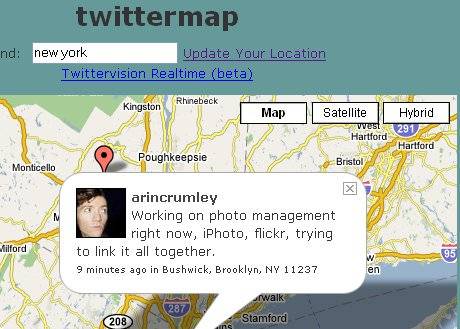
When two services like this are put together, it is likely that something
interesting will emerge. However, not all possible combinations of services are actually
useful. To bring order to the often chaotic world of Mashups, John Musser created
a site called ProgrammableWeb that tracks mashups and APIs.
John’s site forms the basis of much of this post. So let’s head over there to
find out what the big trends are in mashups and APIs today…
High Level API Trends: Google leads the pack
The API section of ProgrammableWeb shows popular APIs. It also has an interesting scorecard that
compares API offerings from web giants like Google and Microsoft. A quick look at the score
card reveals that Yahoo! and Google lead the pack in terms of number of APIs – 22 and 20 respectively.
Amazon, Microsoft and AOL have roughly half of that and eBay has 4.
But in terms of usage, Google
is far ahead of the pack – 1114 Mashups use a Google API. It is also interesting to note that
even though Microsoft has 3 times the APIs of eBay, they both have the same number of Mashups
using their APIs.
Also check out the mashup matrix,
which gives insights as to how APIs cluster with each other. Each
dot in the matrix implies that two APIs are part of the same mashup. One way to
interpret the matrix is that a cluster of dots indicates logical belongings of
APIs, or a natural fit with each other.
Analyzing Mashups: Mapping continues to dominate
The Mashup dashboard
on ProgrammableWeb contains a lot of
interesting statistics about Mashups. On the right, we see the numbers for the past six months.
We conclude that mashups have been growing steadily, but not spectacularly. This is not
surprising, because creating mashups requires time and more importantly technical know-how.
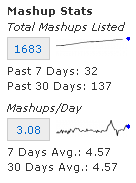
The figure below shows the distribution of tags for mashups. This is calculated by analyzing
the tags across all the mashups posted onto ProgrammableWeb. Mapping is overwhelmingly
the most popular category,
spanning 43% of all mashups. This is not surprising because it all started with
the Google Maps API – and people are still very excited about putting information on a map. Photos, Search and
Shopping tags are roughly equal – with 10% each.
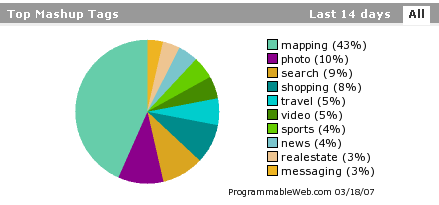
Mashup popularity
ProgrammableWeb currently measures popularity by number of views. This is a bit unfortunate,
particularly because there is no way to sort mashups by rating. As a result, the most popular
mashup – Virtual Places – is
one that does
not have a high rating. It looks interesting and claims to be sophisticated, but it did
not load for me.
The second most popular mashup was called Wii Seeker.
As the name implies, it helps people find nearby locations that have a Nintendo
Wii. It must have been really
popular at some point, but now it looks fairly primitive. The next mashup that caught my attention
was the one in fourth place called Weather Bonk.
This one had a high user rating and was actually very interesting, as it pulled together
live weather, historical information, forecasts and web cameras.
Using Delexa for mashup popularity
Next we briefly leave ProgrammableWeb and head over to
,
a mashup site that uses del.icio.us and Alexa APIs to show the most popular sites by category.
The top mashup tagged by del.icio.us users was
, a
classic mashup
that combines Google Maps and Craigslist to help people find housing.
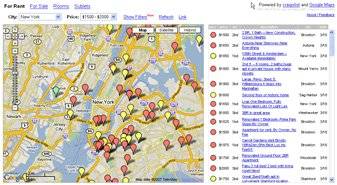
The second most popular mashup according to Delexa was GeoGreeting,
which is more entertaining than useful. This mashup showed geographical locations with buildings
that resembled the shape of the letter that you typed. The third most popular mashup according
to Delexa was Weather Bonk, the same one that caught my eye on ProgrammableWeb.
Analyzing APIs: GoogleMaps used in 50% of mashups
Back now on ProgrammableWeb and the chart on the right demonstrates
the growth of APIs. As with mashups, the actual growth is not that impressive – but it is steady.
As of now, there are close to 400 registered APIs. The way that Programmable Web
measures API popularity seems to be more objective and reliable than is the case
with mashups. The popularity equals the number
of mashups that use the API and the chart below shows the distribution of the most popular
APIs:
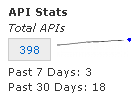
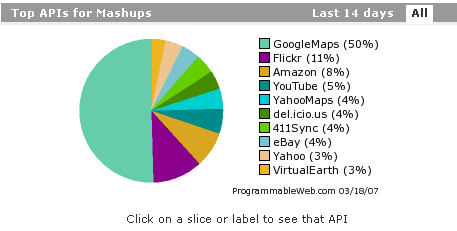
There are few surprises in this information. Google Maps is by far the most popular API,
with 50% of mashups using it. Flickr and Amazon are next with 11% and 8% respectively.
Also, it’s notable that 5% of mashups are using YouTube – which probably corresponds to the recent rise of
video aggregators like Vidmeter. Finally, 4% and total of 74 mashups
use the del.icio.us API.
One API that caught my eye was Cloudalicious,
which shows the distribution of tags for a particular URL over time. This can be insightful in terms of
understanding how people’s perception about your site is changing (or not).
Check out the del.icio.us tag cloud trend for
Read/WriteWeb:
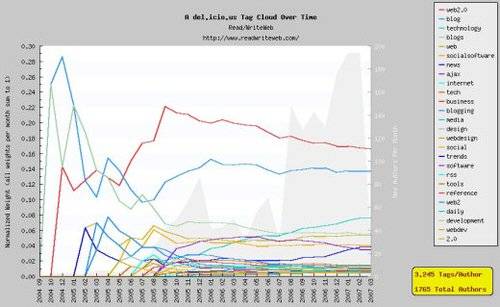
Conclusion
What can we derive from this analysis? It appears that mashups are certainly cool,
but they are not burgeoning. The growth has been steady, but not really explosive. This begs
the question: why?
There are several reasons, the primary one being that most current mashups are
created for fun and not for business. Enthusiasts with some spare time on their hands are
building these during their evenings and weekends, without having monetization in mind. The second
reason is that APIs, as with any software libraries, have a learning curve. Certainly
Internet companies
are trying to expose their services in the simplest possible way, but not everything can be made simple.
Is this what mashups will be – a playground for enthusiasts? I believe that the answer is ‘yes’.
Even though services like Yahoo! Pipes, Teqlo and Dapper are working to simplify the process of
creating mashups, it will likely remain a fairly technical exercise done by enthusiasts.
However,
it is also likely that we will see companies and products taking ideas from many mashups
and creating applications with the combined functionality. For example, taking ideas from
the best
mashups (like Cloudalicious) and creating a set of tools for bloggers and marketers would be
very useful. So mashups will, I think, become the labs of the web – where rapid prototyping
is done by enthusiasts, which gives rise to more integrated offerings by web companies.
Please let us know what your favorite mashup is and give us your take on where
mashups
are heading.





















